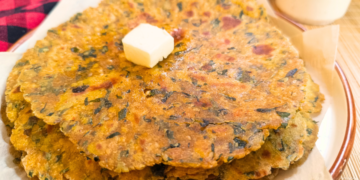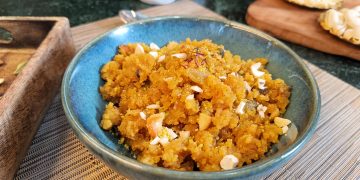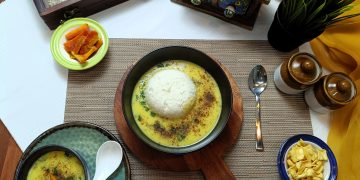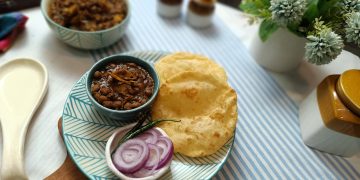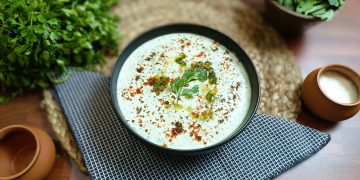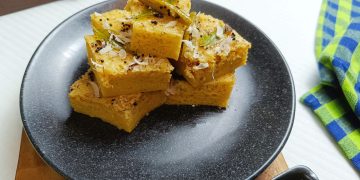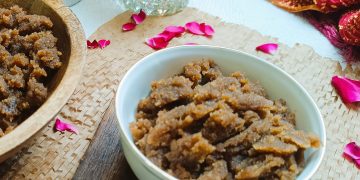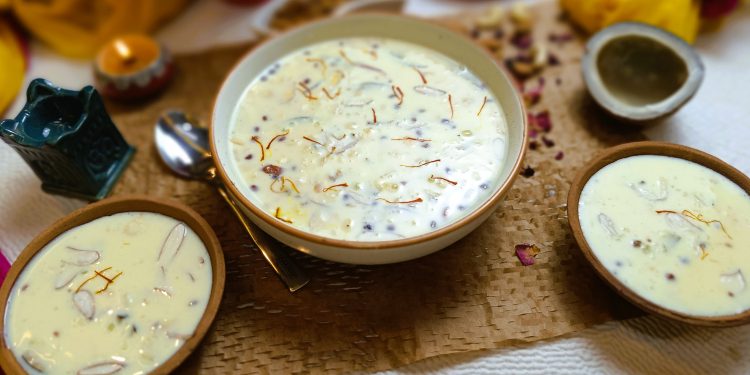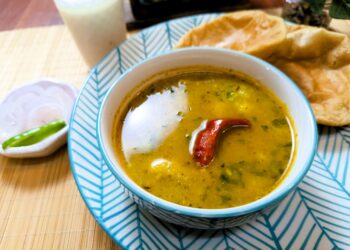Sabudana Kheer, a delicate and creamy dessert, has a special place in Indian kitchens, especially during festivals and fasting periods. Made from sago pearls, or sabudana, this dessert has its roots deeply embedded in traditional Indian cooking. Sabudana is not only a beloved ingredient for its rich texture but also valued for its nutritional benefits during fasting. This kheer, much like its counterparts across the country, serves as a symbol of comfort, nourishment, and divinity.
About the Recipe:
Sabudana Kheer is especially popular during Hindu fasting festivals like Navratri, Ekadashi, and Mahashivratri, where grains and pulses are avoided. Sabudana, being a starch derived from the tapioca root, is considered a permissible ingredient for these fasting days. It is light yet filling, making it ideal for the purpose of sustenance during fasting. While traditionally associated with religious observances, Sabudana Kheer has become a dessert enjoyed by many for its simple and soothing taste.
In many Indian households, preparing sabudana kheer is not just about cooking a sweet dish—it is a ritual connecting to divinity. On auspicious days, kheer is offered as bhog (food offering) to deities, symbolizing purity, devotion, and abundance. The act of making and offering kheer signifies gratitude, and since sabudana is a sattvic (pure) food, it is believed to promote positive energy and blessings from the gods. This connection to spirituality makes sabudana kheer a dish that goes beyond just the palate, reaching the soul.
Ingredients:
To make Sabudana Kheer, you need the following ingredients mentioned below:
Sabudana (Sago Pearls): The star ingredient, sabudana, is rich in carbohydrates and is considered an instant source of energy, especially during fasts. Its chewy, transparent texture adds a beautiful contrast to the creamy milk.
Milk: Full-fat milk is typically used to create the rich, creamy base for the kheer. Milk is symbolic of purity and abundance in Indian culture, and it brings a lush texture to the dish.
Sugar: Used as the sweetener, sugar balances the dish with its sweetness, symbolizing prosperity. Some variations may use jaggery for a deeper, earthy flavor. Here, I’m using condensed milk instead of sugar. It not only sweetens the Sabudana Kheer but also adds a richer, creamier texture due to its thick consistency.
Cardamom: It adds an aromatic depth to the kheer, elevating its flavor.
Nuts (Cashews, Almonds, dry coconut and Chironji seeds): Nuts add texture and richness, while raisins bring a burst of sweetness. Cashews and almonds are often considered auspicious, symbolizing wealth and good fortune.
Saffron (optional): Saffron lends a subtle floral note and a golden hue, symbolizing luxury and divine blessings. You can reserve a few saffron strands for garnishing the kheer before serving.
Serving Suggestions:
Sabudana Kheer can be served both warm and chilled, depending on personal preference and occasion. When served warm, it provides a comforting and nourishing treat, especially in cooler weather or as a prasad after a pooja. Chilled, it becomes a refreshing dessert, perfect for hot days or as part of a festive meal.
For a more festive touch, garnish the kheer with slivers of almonds, cashews, and a sprinkle of saffron.
It can also be served in small silver or brass bowls, adding an elegant, traditional presentation.
Some even like to pair it with other fasting dishes such as vrat wale aloo or singhare ke aate ki puri for a complete meal during fasting periods.
Variations:
Though the classic version of sabudana kheer is made with milk, there are several delicious variations:
Coconut Milk Sabudana Kheer: In regions like Kerala and Goa, coconut milk is used instead of dairy milk, adding a tropical twist to the dessert.
Jaggery: Sweetened Sabudana Kheer: For those who prefer a deeper, earthy sweetness, jaggery can be used instead of sugar. This variation is especially popular in South India.
Vegan Sabudana Kheer: For a plant-based option, almond or oat milk can replace dairy, and jaggery or coconut sugar can be used as a sweetener.
Fruity Sabudana Kheer: Add chopped fruits like ripe mango, banana, or even apple after cooking for a fresh take on the traditional recipe.
Saffron and Rose Water Kheer: For a royal touch, add a few drops of rose water along with saffron, giving it a fragrant and luxurious taste.
Therefore, Sabudana Kheer is more than just a dessert; it is a timeless blend of tradition, spirituality, and comfort. Its rich and creamy texture, combined with the simplicity of its ingredients, makes it a favorite among Indian households, especially during religious occasions. Whether offered to the gods, enjoyed as a festive delight, or savored as a wholesome treat, Sabudana Kheer embodies the essence of Indian culinary heritage. Whether served warm or chilled, with coconut milk or dairy, this dish serves as a reminder of the richness and simplicity that Indian desserts bring to our plates—and our hearts.
So, let’s get started!
Print
Sabudana Kheer Recipe
- Total Time: 4+5 hours + 45 minutes
- Yield: 8–10 1x
Description
Sabudana Kheer is a rich and creamy Indian dessert made from sago pearls soaked in milk and sweetened with condensed milk. Enhanced by the aromatic flavors of cardamom and saffron, it is garnished with chopped almonds, pistachios, and cashews for added crunch. This delightful treat is often enjoyed during festivals and special occasions, embodying the essence of Indian culinary heritage. Here is the recipe:
Ingredients
For Soaking Sabudana:
- 2 cups Sabudana (sago), soaked
For Making Kheer:
- ¼ cup Water
- 2 litres Milk
- 10–12 strands Saffron (soaked in a little milk)
- ¼ cup Almond, sliced or chopped
- ¼ cup cashews (chopped)
- ¼ cup dry coconut, thinly sliced
- 2 tablespoons chironji seeds
- 1 teaspoon Cardamom powder
- 400 grams Sweetened condensed milk
Instructions
Soak the Sabudana:
- Wash 2 cups of sabudana thoroughly to remove excess starch.
- Soak the sabudana in enough water to cover it for about 4-5 hours or overnight until the pearls swell and soften.
To Make the Kheer:
- In a large kadhai or pot, add water and milk.
- Bring the mixture to a boil while stirring.
- Once the milk starts boiling, add the soaked sabudana and stir well to prevent it from sticking to the bottom.
- Cook on low flame, stirring occasionally, until the sabudana becomes translucent and soft, and the milk reduces to three-quarters of its original volume.
- Add the saffron strands soaked in milk, chopped nuts, and cardamom powder. Mix well and add the condensed milk.
- Let it cook for 7-8 minutes, allowing the flavors to meld.
- Remove from heat and let it cool slightly.
- Serve Sabudana Kheer warm or chilled, garnished with additional nuts and a sprinkle of saffron if desired.
Notes
- It is important to wash the sabudana thoroughly to remove excess starch, which can make the kheer gummy. Rinse until the water runs clear.
- For best results, soak the sabudana in enough water to cover it for 4-5 hours or overnight. This allows the pearls to swell and soften adequately, ensuring they cook evenly in the kheer.
- Using a wide, heavy-bottomed kadhai (wok) or pot helps distribute heat evenly and prevents the milk from burning or sticking to the bottom.
- When adding water and milk, stir continuously to prevent scorching or burning. This will also help create a creamy texture.
- Once the soaked sabudana is added, stir occasionally to ensure the pearls do not stick to the bottom and cook uniformly.
- Always cook on low flame after adding the sabudana. This slow cooking allows the milk to reduce properly and the flavors to develop without scorching.
- Keep an eye on the kheer as it cooks, stirring at intervals. The milk should reduce to about three-quarters of its original volume, creating a thick, creamy consistency.
- For a richer flavor and color, soak the saffron strands in warm milk before adding them to the kheer. This ensures maximum flavor infusion.
- You can customize the types of nuts according to your preference. Chopped pistachios or walnuts make great additions for extra crunch and nutrition.
- After adding the saffron, nuts, cardamom powder, and condensed milk, allow the kheer to cook for an additional 7-8 minutes. This step helps meld the flavors beautifully.
- After cooking, let the kheer cool slightly before serving. This helps thicken the kheer further and enhances the flavors.
- Sabudana Kheer can be served either warm or chilled, depending on your preference.
- Prep Time: 4 to 5 hours
- Cook Time: 45 minutes
- Category: Fasting Food, Desserts
- Cuisine: Indian

